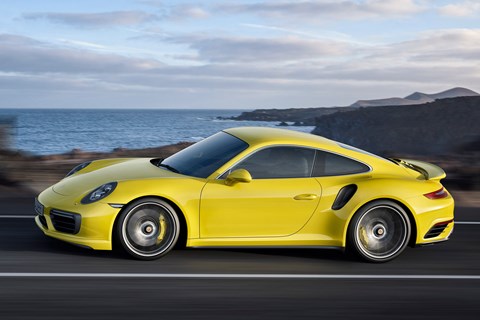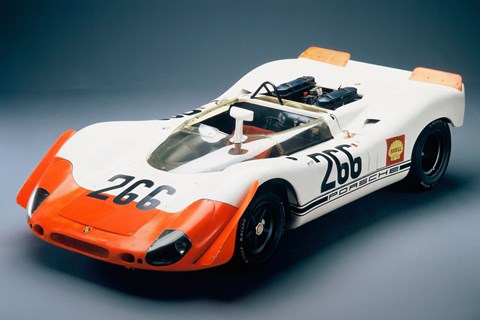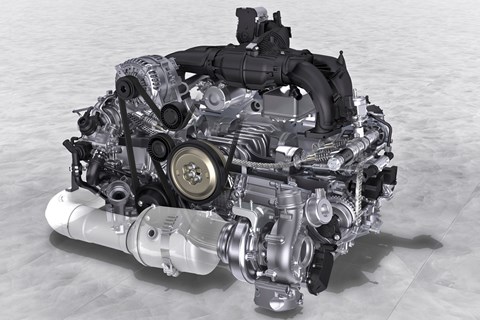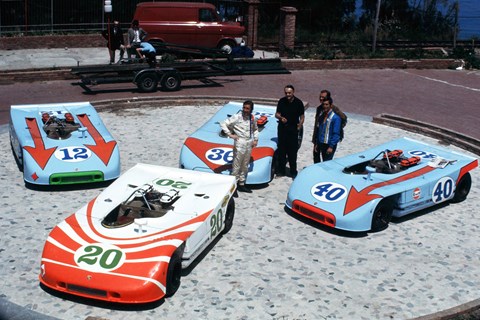► Latest info on mid-engined Porsche 960
► Could use variable compression ratio tech
► Expected to arrive after the next-gen 911
Stay sharp, Ferrari, McLaren and Lamborghini: group tests are potentially going to get a whole lot more interesting in 2019, following the launch of new Porsche 960.
Yes, it looks like Porsche is still working on a new mid-engined supercar that will rival the likes of the 488 GTB, 650S and Huracan.
The long-overdue ‘960’, which is expected to cost around £200,000, will fill the blank in Porsche’s line-up between the 911 Turbo S and the flagship 918 Spyder.
What’s the latest on the 960, then?
It had all been quiet on the 960 front until partway through last year, when Porsche quietly applied for – and was granted, in September 2015 – the ‘960’ trademark. One product the name was earmarked for was a car, suggesting that the long-mooted project was slowly becoming a reality.
When recently queried about the registration, Porsche initially rolled out the response you might expect: ‘We won’t comment on future product. We’re just looking to preserve the nameplate identity and combinations that we don’t have, and to avoid going through the labour of proving a later claim based on our traditions.’
However, the spokesperson added the following: ‘There’s not been much on the topic of new models but, if you look, there are blank spots in our range – and you have to look at what the competition is doing and keep these things in mind.
‘Pragmatically, with our production cycle running as it is, we know where we are in the current model cycles – and there’s a lot to do at the moment. We’re very busy.’
So when will we find out more?
The suggested delay in the 960 project correlates with our previous information, which indicated that the mid-engined Porsche had been shunted back to 2019.
Reputedly, the next-gen 911 – so far dubbed the 992 – will arrive before the new supercar, at some point in early 2018. It’s likely, then, that we won’t hear anything more official until at least next year.
Previously, production of the 960 was mooted to being in February 2017 at the company’s Zuffenhausen-based plant. Production estimates range from 3000-4000 a year, over the course of six years – like the life cycle of the 911.

What can we expect from the 960?
This isn’t going to be a pumped-up Cayman or a reworking of the 911 platform – the 960 will use new underpinnings that will be featured elsewhere in the Volkswagen Group. The structure will be formed primarily of aluminium, while other materials – including high-strength steel, titanium and composites – will be used where appropriate throughout the car.
Reputedly, a weight of 1400kg has been targeted. That should put the 960 on an even keel with the likes of the Ferrari 488 GTB, which clocks the scales at 1370kg dry. An all-wheel-drive version of the 960 would be closer to 1500kg, but would permit it to far better deploy its power and lower its 0-62mph times.
Interestingly, all-wheel steering – as featured in some iterations of the current 911 – has reputedly been discounted by those working on the 960 project, due to its additional weight. You can expect a whole host of other tech, though, including the latest Porsche multimedia system, active aerodynamics and the rotary drive mode selector.
Either way, it’s unlikely an extra few kilos here or there will dent the 960’s performance – because it’s claimed to pack a quad-turbocharged 3.9-litre flat-eight. Sounds unlikely, but there’s reputedly a Cayman running around with a prototype of this engine already fitted – and its power output is rumoured to be in the region of 650bhp.
So, if a subtle-looking Cayman punches past your 650S or R8 V10 on the Autobahn, and proves tricky to catch, it might be worth following until it stops somewhere. While the ‘B8’-engined Cayman is rear-wheel drive, the production version of the 960 is expected to be all-wheel drive initially, with more hardcore rear-drive versions following later down the line.
Porsche has history with flat-eight engines, too; its 907 and 908 racing cars of the ’60s and ’70s were fitted with flat-eights, so there’s motorsports heritage at hand to lend extra appeal – and advertising ammunition – to the new powerplant…

A flat-eight engine? Outside of the above, why?
Using a short, low-slung flat-eight engine will aid the 960’s dynamics, as well as preserve more of the classic Porsche hallmarks. The more exotic powertrain will also help the Porsche justify its premium, as well as make it more appealing alongside the likes of Ferraris – which are generally perceived to have more evocative, interesting engines.
Our sources say that force-fed flat-sixes and V8s were initially considered, but later dispensed with due a variety of issues – including performance, packaging and perception.
Former Porsche chairman Ferdinand Piech is reputed to have signed off the flat-eight engine prior to his departure in April 2015 – and he’s not unfamiliar with the idea, being the custodian of a one-off 914 fitted with an eight-cylinder boxer engine from the 908.
The company has also ploughed a lot of resources into engines with flat configurations, including the recent sixes and fours featured in the latest 991.2, 718 Boxster and 718 Cayman. This will have eased the development of a larger, more powerful version.
Porsche has also previously mentioned prototyping eight-cylinder boxers, for potential use in the 911, lending further credibility to the potential configuration of the 960’s powerplant.
We also think that the Porsche 960 might be the first of the company’s cars to use its new ‘VarioCom’ system, lending its motor some additional potency and giving it a technical edge over its rivals. After all, it would make sense for the latest of Porsche’s technical developments to be rolled out on a new flagship, before trickling down to the rest of the range.
VarioCom? Surely you mean VarioCam?
It’s not a spelling mistake, no – we’re not talking about Porsche’s long-standing variable valve timing system; Porsche has been experimenting with variable compression ratio systems for a while now, going so far as to patent variable-length connecting rods that allow for changes in compression ratio on the fly.
Late last year, it also registered the trademark ‘VarioCom’. Given that ‘VarioCam’ is a portmanteau of ‘Variable Cam’, we’d hazard a guess that ‘VarioCom’ stands for ‘Variable Compression’.
Using variable compression tech would grant the Porsche’s engine a range of benefits, including reduced emissions, smoother running, better responses and improved economy.
When quizzed about the new tech, Porsche responded: ‘The patents support our long-standing reputation for innovation and engineering rigour. How and where such things might manifest into a reality remains to be seen.
‘We’ve taken things from the racetrack to the road and brought about innovations – including brakes and aerodynamics. We’re always looking for a Porsche-specific solution to problems and to come up with robust innovations.’

Why does the compression ratio need to be varied?
Typically, the higher the compression ratio the more efficient the engine. Simply dialling up the compression ratio, however, increases mechanical stress and can lead to detonation when the engine’s working hard. This is when the fuel-air mixture in the cylinder explodes prematurely, due to heating from compression, and tries to drive the upcoming piston down – creating a characteristic rattling noise.
Detonation – also known as knocking or pinking – causes a big drop in performance and can even lead to mechanical damage if sustained. Go for a compression ratio that’s too low, however, and you’ll get sluggish low-speed performance, poor economy and higher emissions. Find a compromise between those two points and you’ll be in business, with a smooth fuel-air mix burn that’s correctly started by the spark plug, but it’ll always be a compromise.
So, employing a variable compression ratio would allow Porsche’s engine to safely produce its best output in a wider range of conditions, bolstering its performance and efficiency across the board. At low speeds and light loads it could have a high compression ratio, for example, granting it clean running and prompt responses.
When accelerating hard, however, the engine needs lots of fuel and air to produce power. A turbocharger does a great job of cramming extra air into the combustion chambers, providing more oxygen to be burnt with fuel, but also causes big increases in combustion chamber temperature – particularly at high boost and compression levels.
To avoid detonation at this point, the compression ratio could be dialled back, keeping the engine at its highest potential output without causing damage. This would be even more important when the engine was operating in a hot climate or in places where the fuel quality isn’t great – as lower quality fuels are more prone to detonation.
Porsche’s patented system uses a connecting rod with an eccentric adjuster at the top, which is controlled by oil flowing through it. This adjuster allows the position of the small end bearing, which attaches the piston’s wrist pin, to be changed – varying the length of the stroke and dynamically altering the compression ratio.
This isn’t a new idea though, is it?
It’s almost identical to a concept demonstrated by FEV Motorentechnik in 2013, among others, yet far simpler than previous concepts – like Saab’s Variable Compression engine. This engine featured a complicated two-piece cylinder block, which effectively allowed the cylinder head to be brought closer to the crankshaft – raising the compression ratio.
Porsche’s patent, published on 5 March 2015, indicates that the company is working with Hilite International to develop this variable compression technology. The two companies have a partnership that spans several years and Hilite is a major supplier in the automotive marketplace. It’s possible, as a result, that the system may be offered to other manufacturers at a later date.
Sounds like the 960 will be quick, in any case
Well, it’ll have to be to keep abreast of the rapidly developing – and increasingly capable – competition. So far, our sources have suggested that the Porsche 960 will be capable of 0-62mph in around 2.5sec, when equipped with an AWD system.
Read our original 2011 scoop story on the Porsche 960 here
